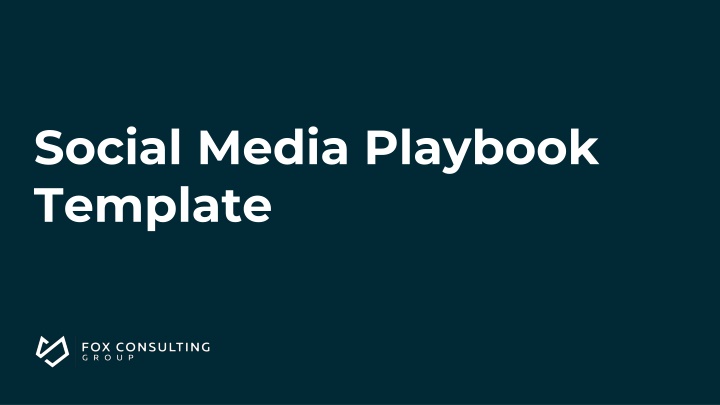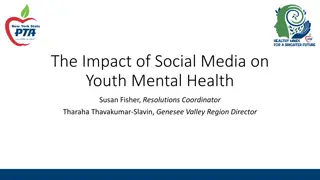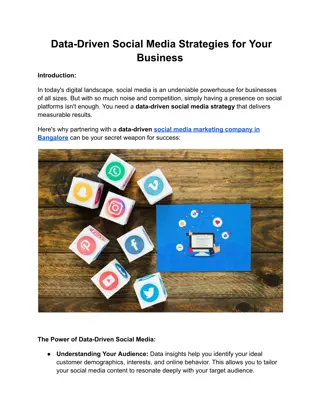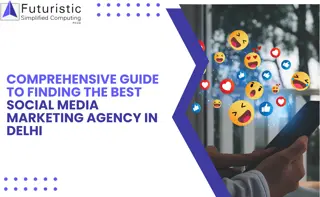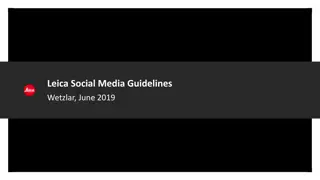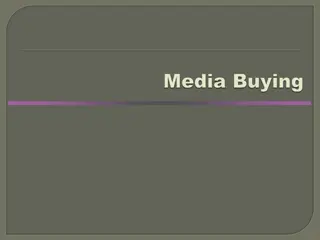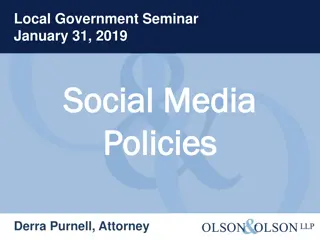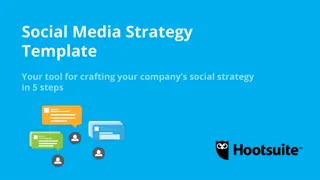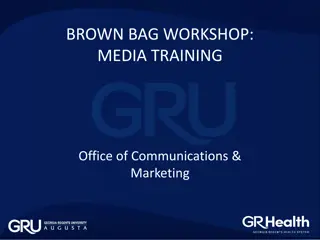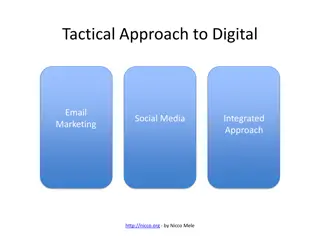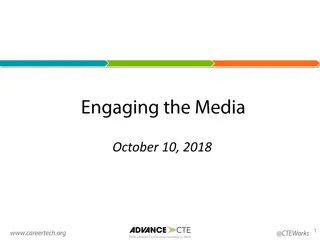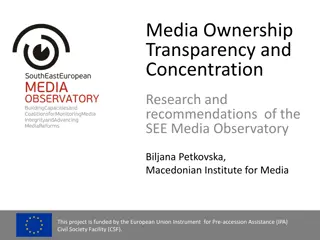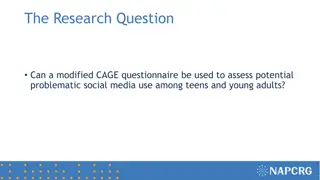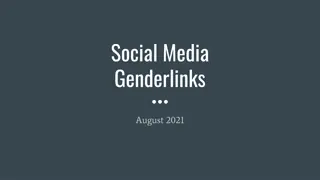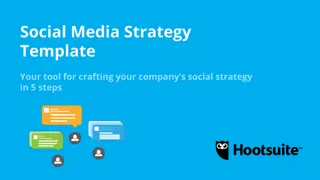Developing Effective Social Media Strategy
Crafting a comprehensive social media playbook involves defining key elements such as content strategy, production, community management, measurement, and process implementation. This playbook template outlines crucial components like business objectives, social media goals, and personas. It guides the creation of content strategies aligned with target audience, channels, and content types. Detailed insights into each aspect help streamline the development of individual channel content strategies for optimal engagement and impact.
Uploaded on Mar 08, 2025 | 1 Views
Download Presentation

Please find below an Image/Link to download the presentation.
The content on the website is provided AS IS for your information and personal use only. It may not be sold, licensed, or shared on other websites without obtaining consent from the author.If you encounter any issues during the download, it is possible that the publisher has removed the file from their server.
You are allowed to download the files provided on this website for personal or commercial use, subject to the condition that they are used lawfully. All files are the property of their respective owners.
The content on the website is provided AS IS for your information and personal use only. It may not be sold, licensed, or shared on other websites without obtaining consent from the author.
E N D
Presentation Transcript
Social Media Playbook Template
5 Key Elements 1. Content Strategy 2. Content Production 3. Community Management 4. Measurement 5. Process & Implementation
Business Objectives The overarching priorities of your business at large. 1. Example: Grow market share in our manufacturing vertical by 15% over the next fiscal year.
Social Media Goals The goals you are working toward on social media to support your company s business objectives. 1. Example: Maintain an average CTR (click through rate) of 5% or higher on advertising campaigns that drive traffic to the manufacturing industry pages on our website.
Personas If your company has not already identified and documented their personas, we recommend you complete this exercise before moving forward with developing your social media strategy. 1. Example: Customers, Prospects, Media, Investors, Employees, etc.
Content Strategy Overview A 30,000 foot overview of your social media strategy. Social Media Goal Target Audience Channel Content Pull from previous slide Pull from previous slide Which social media channel(s) will reach the target audience you ve identified for this goal? What types of content would influence the target audience you ve identified for this goal? Pull from previous slide Pull from previous slide Which social media channel(s) will reach the target audience you ve identified for this goal? What types of content would influence the target audience you ve identified for this goal? Pull from previous slide Pull from previous slide Which social media channel(s) will reach the target audience you ve identified for this goal? What types of content would influence the target audience you ve identified for this goal?
[Individual Channel] Content Strategy Based on the channels you identified on the previous slide, we recommend creating an individual content strategy for each platform. Content Pillar #1 Content Pillar #2 Content Pillar #3 Examples of the types of content that would fall under this category, making a clear distinction between content that exists today and content that needs to be created to support the strategy. Examples of the types of content that would fall under this category, making a clear distinction between content that exists today and content that needs to be created to support the strategy. Examples of the types of content that would fall under this category, making a clear distinction between content that exists today and content that needs to be created to support the strategy. Duplicate this slide for every channel you include in your social media strategy.
[Individual Channel] Publishing Checklist A quick checklist of best practices to run through before publishing or scheduling content. Resize Images and Videos Include UTM Links Include Relevant Hashtags Include up to date image specs for each channel Include company guidelines for UTM tracking and link shortening Link to your hashtag strategy here to ensure branded and unbranded hashtags are included when appropriate Add A Location Tag Other Accounts Other Best Practices Include a reminder to add a location if appropriate to boost visibility and engagement Include a reminder to tag other appropriate accounts to boost visibility and engagement Examples: Keyword research for YouTube videos, Audience Optimization feature for organic content on Facebook, etc. Duplicate this slide for every channel you include in your social media strategy.
[Individual Channel] Guidelines Businesses will leverage each channel a bit differently depending on their objectives, budget and resources. For this reason, we recommend utilizing this space to document company guidelines pertaining to specific features of individual platforms. Examples: LinkedIn Showcase Pages, Instagram Takeovers, Facebook Contests, etc. Duplicate this slide for every channel you include in your social media strategy.
Budget Allocation A breakdown of your social media budget, segmented by objective and channel. We recommend using percentages instead of fixed numbers, knowing budgets are liable to shift throughout the year. Social Media Goal Budget By Objective Channel Budget By Channel Pull from previous slide The boxes in this column should add up to 100% Pull from previous slide Each box in this column should add up to 100% Example: 50% Example: Facebook 50%, LinkedIn 30%, Twitter 20% Pull from previous slide The boxes in this column should add up to 100% Pull from previous slide Each box in this column should add up to 100% Example: 35% Example: Facebook 50%, LinkedIn 30%, Twitter 20% Pull from previous slide The boxes in this column should add up to 100% Pull from previous slide Each box in this column should add up to 100% Example: 15% Example: Facebook 50%, LinkedIn 30%, Twitter 20%
[Individual Channel] Publishing Benchmarks An overview of benchmarks that indicate the publishing cadence of both your company and your top competitors on social media. Brand Month Month Month Your Company Number of posts/month Number of posts/month Number of posts/month Competitor #1 Number of posts/month Number of posts/month Number of posts/month Competitor #2 Number of posts/month Number of posts/month Number of posts/month Competitor #3 Number of posts/month Number of posts/month Number of posts/month Competitor #4 Number of posts/month Number of posts/month Number of posts/month Competitor #5 Number of posts/month Number of posts/month Number of posts/month Duplicate this slide for every channel you include in your social media strategy.
Publishing Frequency Overview An overview of how many posts you intend to publish per channel each month based on the benchmarks on the previous slide and the realities of your staffing resources and marketing tools. [Channel] Posts Monthly Total [Channel] Posts [Channel] Posts [Channel] Posts [Channel] Posts Number of posts/month Number of posts/month Number of posts/month Number of posts/month Number of posts/month Number of posts/month
[Individual Channel] Publishing Frequency A breakdown of the total number of channel posts by content pillar. This will help you put the content strategy you created for each channel into action. Content Pillar Channel Content Pillar #1 Number of posts/month Content Pillar #2 Number of posts/month Content Pillar #3 Number of posts/month Monthly Total Total number of posts/month Duplicate this slide for every channel you include in your social media strategy.
Defining Social Media Assets An overview of the various types of assets required to support a social media strategy. Destination Content: This refers to the content a social post is directing the user to, oftentimes this content lives on the website. Destination content can take the form of landing pages, blogs, articles - anything the social post links to that takes the user off of the platform. Social Media Content: Social media content is the copy written specifically for each platform, that only lives on that channel. Repurposed Content: Not all content needs to be created from scratch. When you consider the small percentage of your organic social audience that has the potential to see a social media post, there is little to no risk in reusing content. Leveraging a blend of new and existing assets will help lighten the load of the monthly content production needs.
Social Media Content Calendar We recommend leveraging a content calendar to ensure all areas of the content strategy are balanced and your publishing cadence is on par with your target. Below is an example to get you started.
Annual Editorial Calendar In order to flesh out the monthly content calendar with actual content, we recommend creating an editorial calendar template to inform the content that is published on social media. This will require collaboration across internal teams on a regular basis. The following is a list of areas to consider when creating your editorial calendar template. Editorial Considerations: Industry Events Relevant Dates Award Nominations Public Relations Company Milestones HR Activities Regional Marketing Team Global Marketing Team Products
Social Request Guidelines If you find yourself regularly fielding requests for social posts from people outside of your department, we recommend documenting and distributing guidelines for internal stakeholders to follow. These considerations will get you started. Guideline Considerations Identify your preferred intake method or tool Communicate the amount of notice you require before posting Request specifics on timeliness of content Request details about the intended audience so you can determine the appropriate channel Request a visual to accompany the content Request links to additional information about the content Request translated text if you are a global company
Community Management Responsibilities An overview of the various types of community management responsibilities. Social Monitoring: Reviewing all notifications and mentions of your brand and responding to them in a timely manner. Social Listening: The practice of identifying trends and uncovering engagement opportunities by analyzing conversations. Social Engagement: Acting on social listening intel by engaging in relevant conversations that may not have directly mentioned your brand.
Social Monitoring An overview of how to monitor your brand on each of the primary social media platforms. We recommend adding any other channels that are included in your social media strategy. Like and reply to comments, mentions, and shares; reply to DMs Like and reply to comments, mentions, and shares; reply to DMs Like and reply to replies, mentions, and retweets; reply to DMs Like and reply to comments and mentions; reply to DMs Like and reply to comments on your videos Brand Notifications Like and comment on videos that mention but don t tag your brand by searching for variations of your brand name Due to privacy restrictions, there is no way to engage with unbranded mentions on LinkedIn Due to privacy restrictions, there is no way to engage with unbranded mentions on Facebook Like and reply to tweets that mention but don t tag your brand by searching for variations of your brand name Like and reply to posts that mention but don t tag your brand by searching for variations of your brand name Unbranded Mentions
Social Listening Manually conducting social listening research and identifying trends can be a time-consuming task. Implementing a marketing technology solution can alleviate bandwidth concerns and elevate the level of insights provided by leveraging AI to identify trends and patterns. We recommend segmenting your social listening approach into three primary categories. Brand Insights Industry Insights Competitor Insights Get a pulse on brand health by understanding audience sentiment Get content ideas based on timely conversations and topics with high volume Get inspired with content ideas based on what competitor content is performing well Discover employee content to share Uncover thought leadership opportunities brand SMEs can contribute to Analyze competitor content and identify gaps where your company can stand out Include a comprehensive list of branded hashtags to monitor Include a comprehensive list of industry related hashtags to monitor Include a comprehensive list of competitor handles and hashtags to monitor
Social Engagement You can generate valuable engagement by participating in relevant conversations online, but it is important to evaluate when it s appropriate to engage. Creating comprehensive social engagement guidelines requires a deeper exploration of a brand voice and tone that should be presented to and approved by internal stakeholders, but these tips will get you started. Brand Opportunities Industry Opportunities Competitor Opportunities An employee is talking about the company in a positive way Conversations related to the core applications of your products or services, often referred to as solutions or verticals (Example: big data, IoT, etc.) It is almost never appropriate to engage in conversation with a competitor, though there are some exceptions when friendly banter aligns with the brand A media outlet or journalist shares a positive story about the brand An influencer in your industry mentions the brand Conversations around your company s core values (Example: sustainability) Avoid getting in the middle of conversations with or about competitors as it can reflect negatively on the brand A customer or partner mentions the company in a positive light
Social Media Reporting An overview of the two primary types of social media reporting. This distinction will help you communicate the most valuable, relevant metrics to the right internal stakeholders. Macro Level Reporting Quarterly | Annually Macro level reporting focuses on the metrics internal stakeholders at the executive level will be interested in. This data demonstrates how social media has contributed to achieving business objectives. Micro Level Reporting Weekly | Monthly Micro level reporting focuses on the more granular metrics that indicate content performance. This data is used by the tactical team to inform overall strategy and content direction.
[Individual Channel] Reporting KPIs We recommend aligning your social media goals with specific KPIs to ensure you are measuring your performance in a consistent and meaningful way. The template below will get you started. Social Media Goals Organic Social Media KPIs Paid Social Media KPIs Google Analytics KPIs Pull from previous slide Examples: Followers, Reach, Impressions, Engagements, Engagement Rate Examples: Conversions, Conversion Rate, Cost Per Conversion Examples: Sessions, Bounce Rate, Pages/Session, Average Session Duration, Goal Completions Pull from previous slide Examples: Followers, Reach, Impressions, Engagements, Engagement Rate Examples: Conversions, Conversion Rate, Cost Per Conversion Examples: Sessions, Bounce Rate, Pages/Session, Average Session Duration, Goal Completions Pull from previous slide Examples: Followers, Reach, Impressions, Engagements, Engagement Rate Examples: Conversions, Conversion Rate, Cost Per Conversion Examples: Sessions, Bounce Rate, Pages/Session, Average Session Duration, Goal Completions Duplicate this slide for every channel you include in your social media strategy.
[Individual Channel] KPI Targets Once you ve identified and defined what you will measure, we recommend including specific goals for each KPI. Be sure to include date references (i.e. per month). Reference these benchmarks when evaluating social media performance and creating reports for various internal stakeholders. Social Media Goals Organic Social Media KPIs Paid Social Media KPIs Google Analytics KPIs Pull from previous slide Assign goals to KPIs Assign goals to KPIs Assign goals to KPIs Example: Acquire 30 Twitter followers per month Example: Maintain a CTR of 5% or greater on LinkedIn ads Example: Garner 150 pageviews on manufacturing pages per month Pull from previous slide Pull from previous slide Duplicate this slide for every channel you include in your social media strategy.
Quarterly Tactics Identify the tactics that need to be completed on a quarterly basis to uphold the strategy you put together. Below is a list to get you started. Update saved audiences across all social ad accounts to keep targeting parameters up to date. Review social listening hashtags and add to or remove as needed. Use upcoming campaigns and editorial content as a way to uncover new niche conversations to monitor. Produce quarterly reports by channel and campaign to identify major fluctuations and adjust accordingly. Share with internal stakeholders as appropriate.
Monthly Tactics Identify the tactics that need to be completed on a monthly basis to uphold the strategy you put together. Below is a list to get you started. Schedule monthly content, knowing timely posts will need to be added throughout the month. Turn on or schedule any paid social ads slated for the month. Identify and document top performing content. Use these insights as a tool when planning next month s content calendar. Share with internal stakeholders as appropriate. Identify emerging themes within the industry using social listening to uncover trends. Monitor competitor social listening handles and hashtags to discover top performing content. Create next month s content calendar. Determine new asset needs and assign. Create a strategy for next month s paid social ads. Meet with internal teams to learn about upcoming events. Update the editorial calendar.
Weekly Tactics Identify the tactics that need to be completed on a weekly basis to uphold the strategy you put together. Below is a list to get you started. Monitor brand social listening hashtags to find employee content and share on the corporate channels. Use the content strategy as a guide for what type of content is appropriate to share. Monitor industry social listening hashtags to find relevant conversations and proactively engage in them to increase brand visibility and boost thought leadership. Review a weekly analytics dashboard to identify major fluctuations and adjust accordingly. Share with internal stakeholders as appropriate.
Daily Tactics Identify the tactics that need to be completed on a daily basis to uphold the strategy you put together. Below is a list to get you started. Notify employees who have created content (blogs, articles, UGC on Instagram, etc.) and notify them when something they have contributed to has been posted on the company s channels. Monitor paid campaign KPIs, ad spend, and ad variant testing. Optimize ad campaigns based on performance. Monitor notifications on all channels. Respond to positive brand mentions in a timely manner and alert the crisis communications team of reputable negative brand mentions.
